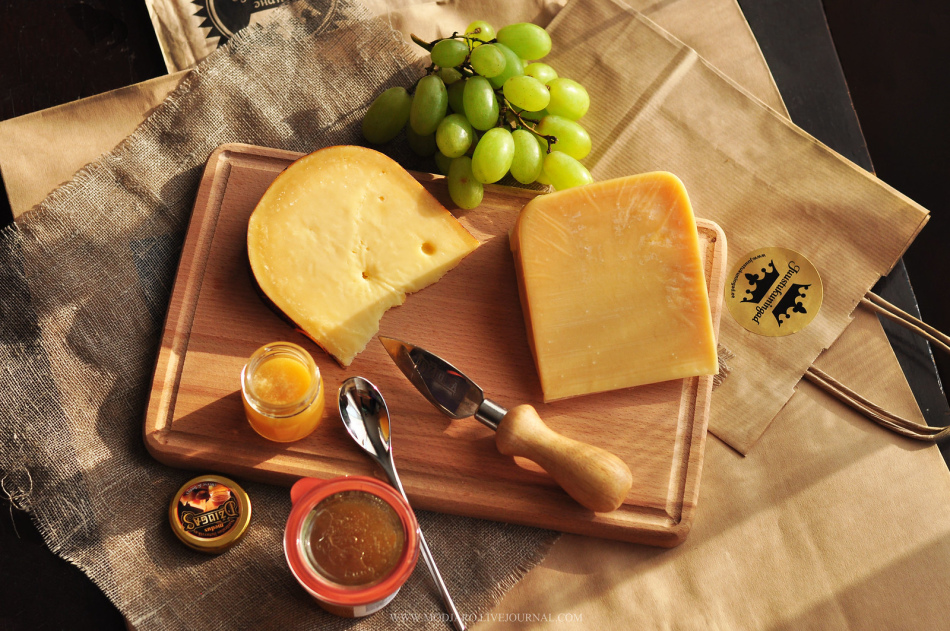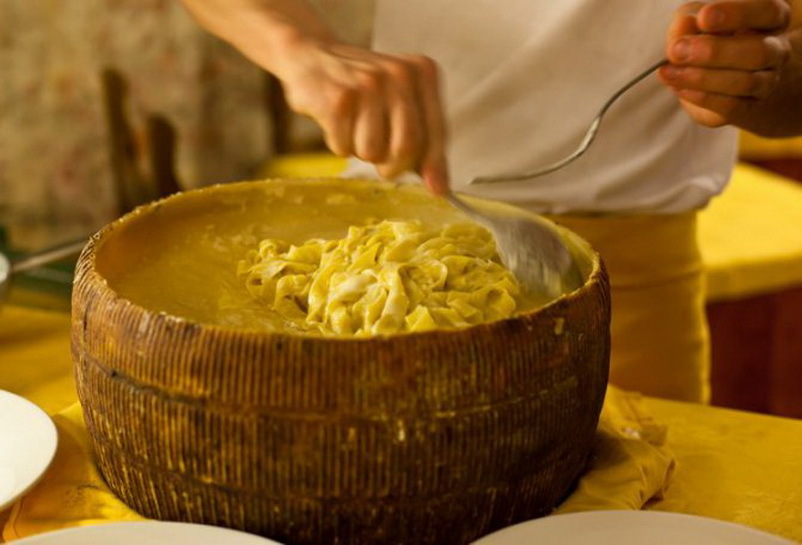This article will describe in detail how to prepare Parmesan cheese at home. You will also learn which products to use and all the subtleties of cooking for this.
Content
Not a single Italian can resist the cheese of Parmesan, it was in Italy that he was made for the first time. This product goes well with alcohol, especially wine, it is melted, salads are made with cheese. It is also added to pastes, risotto, pizza. And you can eat it in its purest form. As a separate dish, it is also very pleasant to taste. The original name of the cheese is Parmigiano Reggiano. It should be prepared from a cow's milk. The ripening time of the product is about six months. When the cheese is ready, it has an original taste with the aroma of fruits, nuts, with the smell of cheese, which is not comparable with anything.
The story of the cheese Parmesan
There are no genuine data on how the cheese Parmesan appeared. But there is still some information about this. According to historical data, the age of cheese is about a thousand years. Some sources mention that the cheese was invented by the monks of the Benedictine monastery. It was important for these people to cook only natural products. And it is important that such food is stored for a long time. According to the legend, the Lord God himself opened the recipe for cheese.

Ready cheese, even without additives, can retain its qualities for almost three years. The cheese recipe has not changed, in the thirteenth century it was prepared using the same technology. And the real cheese of Parmesan is produced only in the northern part of Italy.
Secrets of cooking cheese Parmesan
Parmesan is added to the cheese. However, only dairy products with a small fat content are suitable for the product, and even better fat. At the beginning of the process, the milk should be heated to 38 degrees, then only add leaven. About an hour, this sourdough occurs. In the event that you use pasteurized or whole milk for the manufacture of cheese, then it is not necessary to add leaven.
The home product is made from low -fat milk, as mentioned earlier, the process of cooking is long, about five months, or even more.

IMPORTANT:You can improve the aroma, the taste of cheese can be added to the cow's milk also a goat to one.
The harm and benefits of the cheese parmesan
It is very convenient that Parmesan cheese can be stored for a long time. Therefore, this product is ideal for travelers. There is And others its qualities that need to be emphasized:
- The cheese has a large number useful amino acids. Without which the human body cannot exist.
- The product has a high content protein compoundsTherefore, it can be consumed when losing weight. So the body will receive the required amount of proteins, and a feeling of hunger will not be felt.
- Cheese calorie product, 100 grams contains about 390 kilocalories. With normal consumption of the product, weight gain does not occur. Cheese
- Parmesan is generally quickly absorbed in the body systems, is useful for patients with gastrointestinal diseases.
- It contains a lot calcium, phosphorus. After all, it consists of milk.
- The product also contains many vitamins, beneficial components, are recommended to be used for children, pregnant.
- It is great that in such a useful product no lactoseTherefore, people with intolerance to lactose will not harm people.

If we talk about the harmful qualities of cheese, then he has practically no. This natural product can bring unpleasant surprises only to those people who have intolerance to at least one component, which are part of it.
Parmesan cheese is a description of the product, the timing of manufacturing it
At home, few people make cheese, this is a fairly long process, therefore it is better to do it professionally. And yet, if you buy cheese in a supermarket, then you can doubt it in its quality. Therefore, it is better to cook Parmesan cheese yourself. Although the production technology is quite complicated, after completing the entire procedure for preparing the product at the output you will get a unique result.
The cheese recipe does not change for many years, and the Parmesan variety is one of the best. According to the Italian standard, Parmesan has high quality. Thanks to the cultivated powder of the mushrooms that share the layer of mass of the product, there is a feeling of separation in the form of marble vines. The view in his section is amazing.
Most often, they produce cheese in the form of a circle, which is cut in half horizontally. There are main stages in the production of the product, there are three of them, which last a total of three months. It is prepared from the milk of cows, as a result, the product is yellow with cream holes with neat holes, a sweet hazelnut. Over time, the aroma of cheese acquires brighter shades.

IMPORTANT: To get a quality product, you should be patient, because parmesan's ripening lasts almost a year. With such an endurance of the product, its taste becomes saturated and unique. The finished product is stored in a cold place in plastic packages. And it is better that they are sealed. If you want to save the product for a longer period, then place it in a jar and pour it with salted water.
How to cook Parmesan cheese at home?
Preparation of the cheese Parmesan will take a lot of time, because you will need to be patient and prepare the necessary tools, containers and products for cheese.
Ingredients:
- Small milk - 10 liters
- Sources for the manufacture of yogurts - 0.25 tsp. 1/4 tsp Sourds for yogurt (suitable YO-MIX 883 Danisco)
- Liquid loose enzyme 0.5 tsp. (it is diluted in a glass of 50 ml. Water room t)

Auxiliary equipment:
- Capacity with a cover of 11 liters
- Round capacity for cheese per 2 kg
- Knife
- Press
- Lavsan drainage bag
- Thermometer for liquid
- Tablespoons of different sizes
Recipe:
- For the cheese Parmesan, it is necessary to mix the evening milk without cream and whole milk. And the second should be the fresh one, the better.
- Next, heat the resulting milk to thirty -three degrees. Sprinkle the starter at the top, mix thoroughly in two minutes. Leave for one hour the resulting mass in a warm place. To keep the temperature within thirty -three degrees.
- In an hour, add an enzyme to the milk, mix the mass. And after 16 minutes you will notice how the clot forms. Take your time, a clot can appear in nine minutes, but it must be cut off no earlier than 16 minutes.
- Thanks to this endurance, the desired finely granular texture will be released, which distinguishes Parmesan cheese from other products.
- The clot is cut horizontally with a knife and vertically. Moreover, during the cutting process, the mass should be mixed for about ten minutes, so the fine -grained base is obtained.
- Next, heat the composition to fifty eight degrees, mix. The process should last about twenty minutes. Fine -grained texture and rapid heating can make grain dry, therefore you can not rush with heating and you need to do this in a water bath.
- After the heating process, you will need to cool the cheese up to fifty -five degrees. To do this, you can place the container in cold water. Stir the mass for eight minutes at least. Grain will begin to be consolidated, to check for readiness, burn a handful. The result is a dense piece that should not crumble.
- Take a fabric or drainage bag, place in a colander, strain the entire mass. Collect the ends of the fabric, then tie it. The remaining liquid is slowly heated to fifty seven degrees, a drainage bag with mass is lowered into it, and a product is maintained for about an hour in a 55-degree serum. The excerpt process must be accompanied by coups of cheese mass once every 15 minutes. It is necessary that the entire product is immersed in water.
- Next, move the cheese directly to the rags to a pre -prepared container. Straighten everything so that there are no bruises. Spread it with your hands in a container, let it take its shape, become more flat, press on top with a lid.
- There should be holes in this container so that the serum drains under the influence of the press. Twenty minutes later, the press is removed, the cheese is wrapped with a clean cloth, and all the bruises are straightened again. The weight of the press should be at least 4.5 kg.
- After forty minutes, the cheese is again wrapped, and already placed under a press weighing 10.5 kg. They also wait for twenty minutes of such oppression and all the time wrap the cheese in clean fabric.
- When forty minutes pass under the press 10.5 cheese is straightened in the same form, it becomes easier. And they are already pressed for at least ten hours. The temperature of the product should not be below 18 degrees. Otherwise, bacteria will simply not perform the oxidation process. It is also impossible that the temperature rises above 25 degrees. The product will turn out very sour, will increase in size.
- After ten hours, the cheese is pulled out of the form, then transferred to the container. Again, it is kept at room temperature so that beneficial bacteria work. For the process it is necessary 35 hours.
- The next thing you need to do is to seize the product. Heat four liters of water, pour one kilogram of salt there. When the salt dissolves, cool the brine, and then place the cheese there, let it suck. It is enough to seize the cheese on the one hand - 6 hours, after it is turned and salted on the other hand, the same time. The cheese floats on the surface, so it should be sprinkled with dry salt from above. It is desirable that the pickup temperature is about 12 degrees.
- After the boot, the product is taken out, put on a bars, where it dries. Dry the product in a cool place at a temperature of not higher than 13 degrees. So that he dries evenly, turn Parmesan turn over.
After drying, a dry crust forms. Then the cheese is moved to another room where the next temperature regime will be observed - the temperature should not rise above 15 degrees and fall below 10. The humidity in the room should correspond to 85 percent. So the cheese stores a year. If mold will form on the product, then it is washed off with a cloth that is dipped in a brine. Rapshaft recipe: 4 liters of water + 1 kg of salt + 25 ml of vinegar 9 percent + 25 ml of calcium chloride (8 %).

IMPORTANT: After processing the product with a brine, Parmesan must be wiped dry. In fifteen days, the crust will be hard and dried, the mold will cease to appear. Therefore, to improve the condition of the crust, lubricate it with oil olives. Thanks to, to which the crust will not dry out and the mold will cease to form.
Even on our portal you can find articles on a similar topic here:







